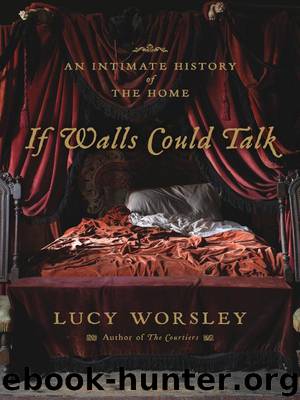If Walls Could Talk by Worsley Lucy

Author:Worsley, Lucy [Worsley, Lucy]
Language: eng
Format: mobi, epub
Publisher: Bloomsbury Publishing
Published: 2012-02-27T22:00:00+00:00
25 – Sitting Comfortably
The common sitting room [is] an Englishman’s delight to show his wealth.
Robert Southey, 1807
At the heart of living-room life is the chair: whether for resting, writing (a much more important part of everyday life before the telephone), reading or talking. In a medieval house, only the lord or owner was allowed to sit down, while everyone else stood and watched.
The book of poems by Charles, Duc d’Orléans, written while he was a prisoner in the Tower of London after his capture at the battle of Agincourt in 1415, contains an excellent illustration of a medieval living room (plate 21). The duc sits in the best place, before the fire, while his retainers await his orders (his chaplain in red). The floor of the room is beautifully tiled; its walls have been hung with the tapestries which hide an interloper or eavesdropper in many a tale from the Middle Ages.
This was medieval life for the grand: the temporary occupation of an endless succession of draughty castles, each furnished quickly but luxuriously for the occasion. It’s almost like camping: each night the whole set-up could be recreated somewhere new. A medieval king moved around his realm constantly to show himself to his subjects, physically maintaining law and order, while his aristocrats peregrinated round their estates in order to consume upon the spot the annual proportion of the crop owed to them as landlords. King Edward III (1312–77) and his wife Philippa had such a nomadic life that their numerous children were born variously at the Tower of London, Windsor, Woodstock, Antwerp, Clarendon, Ghent, Hatfield, Langley and Waltham in Essex.
This is why the French still call their furniture mobiliers, or ‘removables’: many pieces did indeed follow their owners round the country from castle to manor. Many surviving examples of medieval furniture are either easily movable or demountable.
Perhaps the classic furnishing item for the mobile household was tapestry. It served several purposes. Tapestries are portable and flexible, able to eliminate the draughts from spaces of different size and shape. Secondly, they can convey iconographic messages through their design, sending out signals about their owners’ erudition or aspirations. Henry VIII favoured a set telling the biblical story of Abraham, for example, which is about an ageing man’s ultimately successful search for a male heir; Henry himself took encouragement from this. Thirdly, tapestry is a wonderful form of conspicuous consumption, especially if woven with gold or silver thread. Cardinal Wolsey had a closet hung with cloth of gold, and had more than 600 tapestries in his collection. A Venetian ambassador was amazed to describe how, when visiting the cardinal, ‘one has to traverse eight rooms before one reaches his audience chamber, and they are all hung with tapestry’. Even more impressively than that, the tapestry displayed was ‘changed every week’.
The great hall of a medieval house was essentially the only living room for its lower servants, and we already know that it also served as their bedroom. Any leisure time would be spent there, playing dice or singing.
Download
This site does not store any files on its server. We only index and link to content provided by other sites. Please contact the content providers to delete copyright contents if any and email us, we'll remove relevant links or contents immediately.
| Africa | Americas |
| Arctic & Antarctica | Asia |
| Australia & Oceania | Europe |
| Middle East | Russia |
| United States | World |
| Ancient Civilizations | Military |
| Historical Study & Educational Resources |
Underground: A Human History of the Worlds Beneath Our Feet by Will Hunt(12027)
Sapiens by Yuval Noah Harari(5295)
Navigation and Map Reading by K Andrew(5111)
The Sympathizer by Viet Thanh Nguyen(4307)
Barron's AP Biology by Goldberg M.S. Deborah T(4100)
5 Steps to a 5 AP U.S. History, 2010-2011 Edition (5 Steps to a 5 on the Advanced Placement Examinations Series) by Armstrong Stephen(3692)
Three Women by Lisa Taddeo(3356)
Water by Ian Miller(3129)
The Comedians: Drunks, Thieves, Scoundrels, and the History of American Comedy by Nesteroff Kliph(3042)
Drugs Unlimited by Mike Power(2545)
A Short History of Drunkenness by Forsyth Mark(2236)
DarkMarket by Misha Glenny(2167)
The House of Government by Slezkine Yuri(2162)
And the Band Played On by Randy Shilts(2132)
The Library Book by Susan Orlean(2042)
Revived (Cat Patrick) by Cat Patrick(1963)
The Woman Who Smashed Codes by Jason Fagone(1929)
Birth by Tina Cassidy(1866)
The Absolutely True Diary of a Part-Time Indian by Sherman Alexie(1860)
